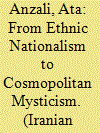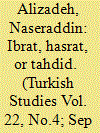| Srl | Item |
| 1 |
ID:
186549


|
|
|
|
|
| Summary/Abstract |
This article examines the life and works of Hossein Kazemzadeh Iranshahr, focusing on the evolution of his thought from an ardent nationalist to a cosmopolitan mystic. It offers a detailed account of the spiritual transformation that Iranshahr went through around 1920 in Europe—a topic that has never been addressed in existing scholarship. It contextualizes his esoteric views, especially the influence of Theosophy on his thought in the context of the so-called “Occult Revival” in Weimar Germany. Finally, it discusses how Iranshahr's emerging spiritual worldview impacted his intellectual outlook, especially his views on religion, nationalism, civilization, and race.
|
|
|
|
|
|
|
|
|
|
|
|
|
|
|
|
| 2 |
ID:
180533


|
|
|
|
|
| Summary/Abstract |
This study examines the ways in which various aspects of Turkish modernity, including gender reforms and nation-building, were reconstructed by the Berlin Circle, whose members were the ideologues of nationalist authoritarian modernization in Iran. To this end, I analyzed texts published between 1923 and 25 in Iranshahr and Nameye Farangestan, two important periodicals of the Berlin Circle. The results of this study show that while gender reforms were welcomed, longingly desired [hasrat], and upheld as a lesson [ibrat], Turkish nationalism was mostly perceived as a threat [tahdid]. This decentralized and horizontal view towards Turkish modernity suggests that its reconstructed image served to transfer and propagate different messages that implied the possibility of modernization reforms in an Islamic country like Iran and induced anxieties to push Iranian society to an imagined ideal future.
|
|
|
|
|
|
|
|
|
|
|
|
|
|
|
|